Developing Employee Engagement for Company Growth at Handy Holdings
VerifiedAdded on 2023/05/30
|49
|11656
|463
Report
AI Summary
This report investigates the significance of employee engagement for organizational development, using Handy Holdings as a case study. It explores the current level of employee engagement within the company, identifies underlying factors, and proposes recommendations for improvement. The research employs a mixed-methods approach, combining literature review with survey questionnaires and interviews. Findings indicate a low employee engagement rate due to rigid work schedules, leading to high turnover. The report suggests strategies such as leadership training, employee empowerment programs, flexible work shifts, and revised compensation policies to enhance employee engagement and foster company growth. Desklib offers a platform to access this and similar assignments.
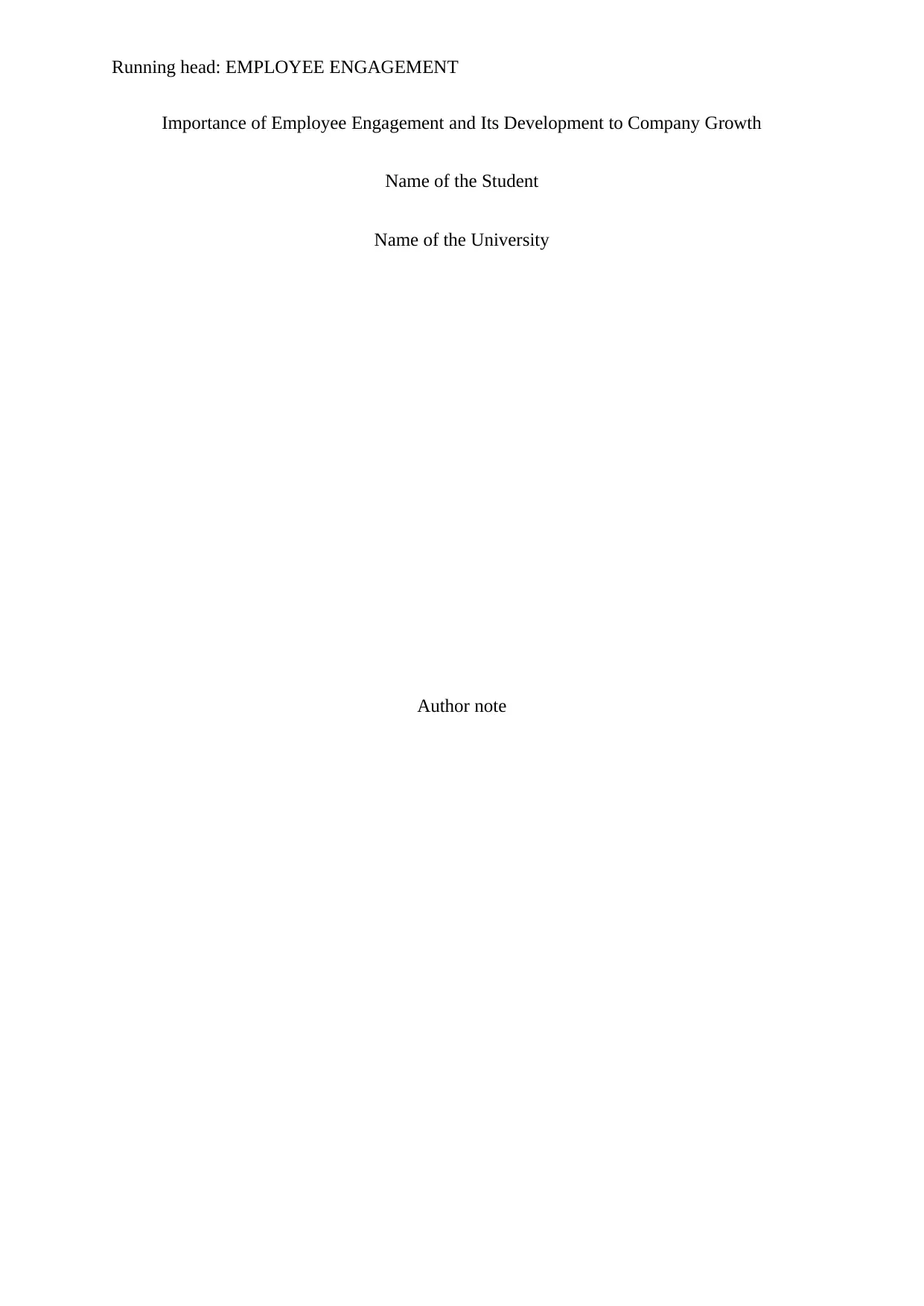
Running head: EMPLOYEE ENGAGEMENT
Importance of Employee Engagement and Its Development to Company Growth
Name of the Student
Name of the University
Author note
Importance of Employee Engagement and Its Development to Company Growth
Name of the Student
Name of the University
Author note
Paraphrase This Document
Need a fresh take? Get an instant paraphrase of this document with our AI Paraphraser
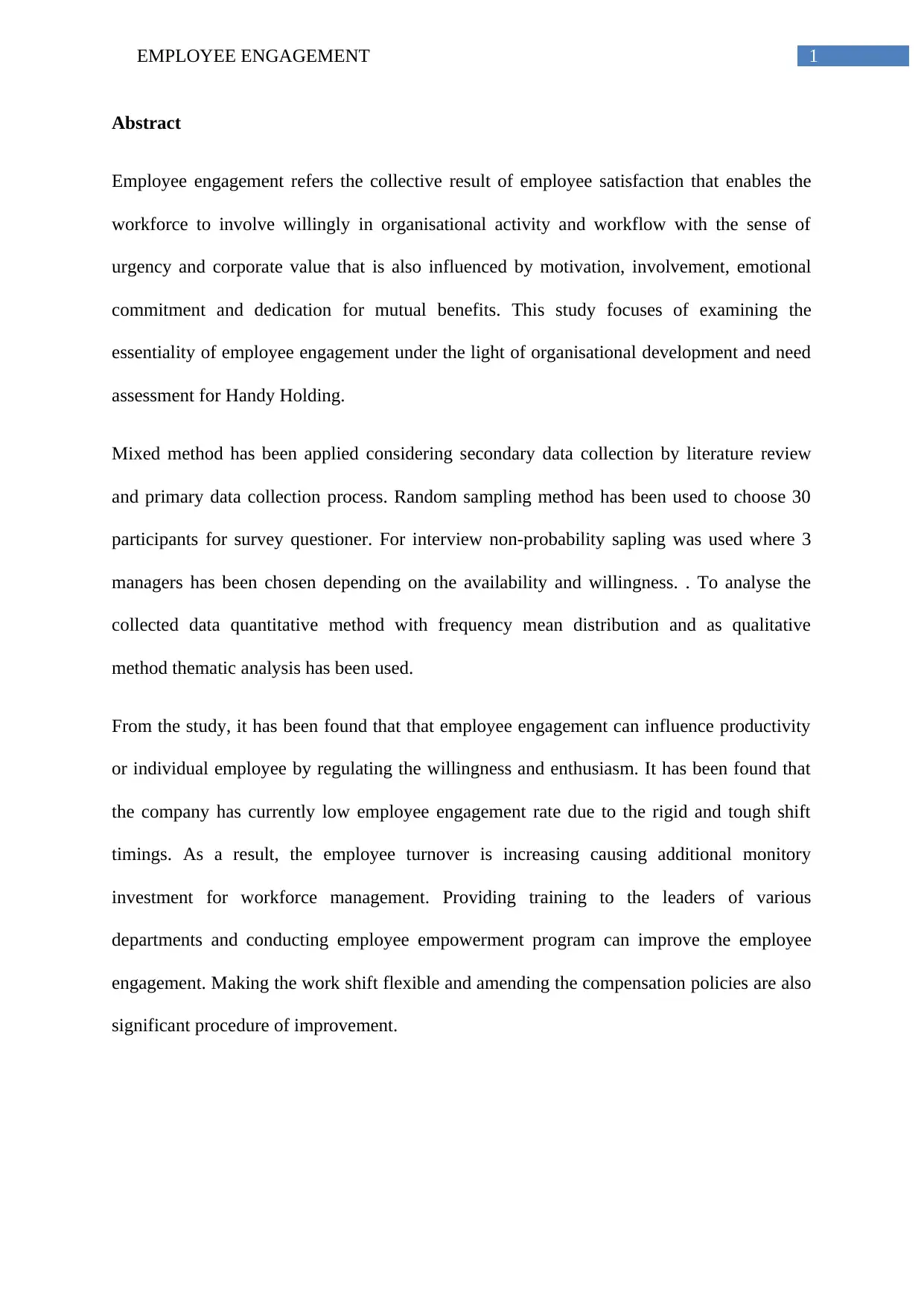
1EMPLOYEE ENGAGEMENT
Abstract
Employee engagement refers the collective result of employee satisfaction that enables the
workforce to involve willingly in organisational activity and workflow with the sense of
urgency and corporate value that is also influenced by motivation, involvement, emotional
commitment and dedication for mutual benefits. This study focuses of examining the
essentiality of employee engagement under the light of organisational development and need
assessment for Handy Holding.
Mixed method has been applied considering secondary data collection by literature review
and primary data collection process. Random sampling method has been used to choose 30
participants for survey questioner. For interview non-probability sapling was used where 3
managers has been chosen depending on the availability and willingness. . To analyse the
collected data quantitative method with frequency mean distribution and as qualitative
method thematic analysis has been used.
From the study, it has been found that that employee engagement can influence productivity
or individual employee by regulating the willingness and enthusiasm. It has been found that
the company has currently low employee engagement rate due to the rigid and tough shift
timings. As a result, the employee turnover is increasing causing additional monitory
investment for workforce management. Providing training to the leaders of various
departments and conducting employee empowerment program can improve the employee
engagement. Making the work shift flexible and amending the compensation policies are also
significant procedure of improvement.
Abstract
Employee engagement refers the collective result of employee satisfaction that enables the
workforce to involve willingly in organisational activity and workflow with the sense of
urgency and corporate value that is also influenced by motivation, involvement, emotional
commitment and dedication for mutual benefits. This study focuses of examining the
essentiality of employee engagement under the light of organisational development and need
assessment for Handy Holding.
Mixed method has been applied considering secondary data collection by literature review
and primary data collection process. Random sampling method has been used to choose 30
participants for survey questioner. For interview non-probability sapling was used where 3
managers has been chosen depending on the availability and willingness. . To analyse the
collected data quantitative method with frequency mean distribution and as qualitative
method thematic analysis has been used.
From the study, it has been found that that employee engagement can influence productivity
or individual employee by regulating the willingness and enthusiasm. It has been found that
the company has currently low employee engagement rate due to the rigid and tough shift
timings. As a result, the employee turnover is increasing causing additional monitory
investment for workforce management. Providing training to the leaders of various
departments and conducting employee empowerment program can improve the employee
engagement. Making the work shift flexible and amending the compensation policies are also
significant procedure of improvement.
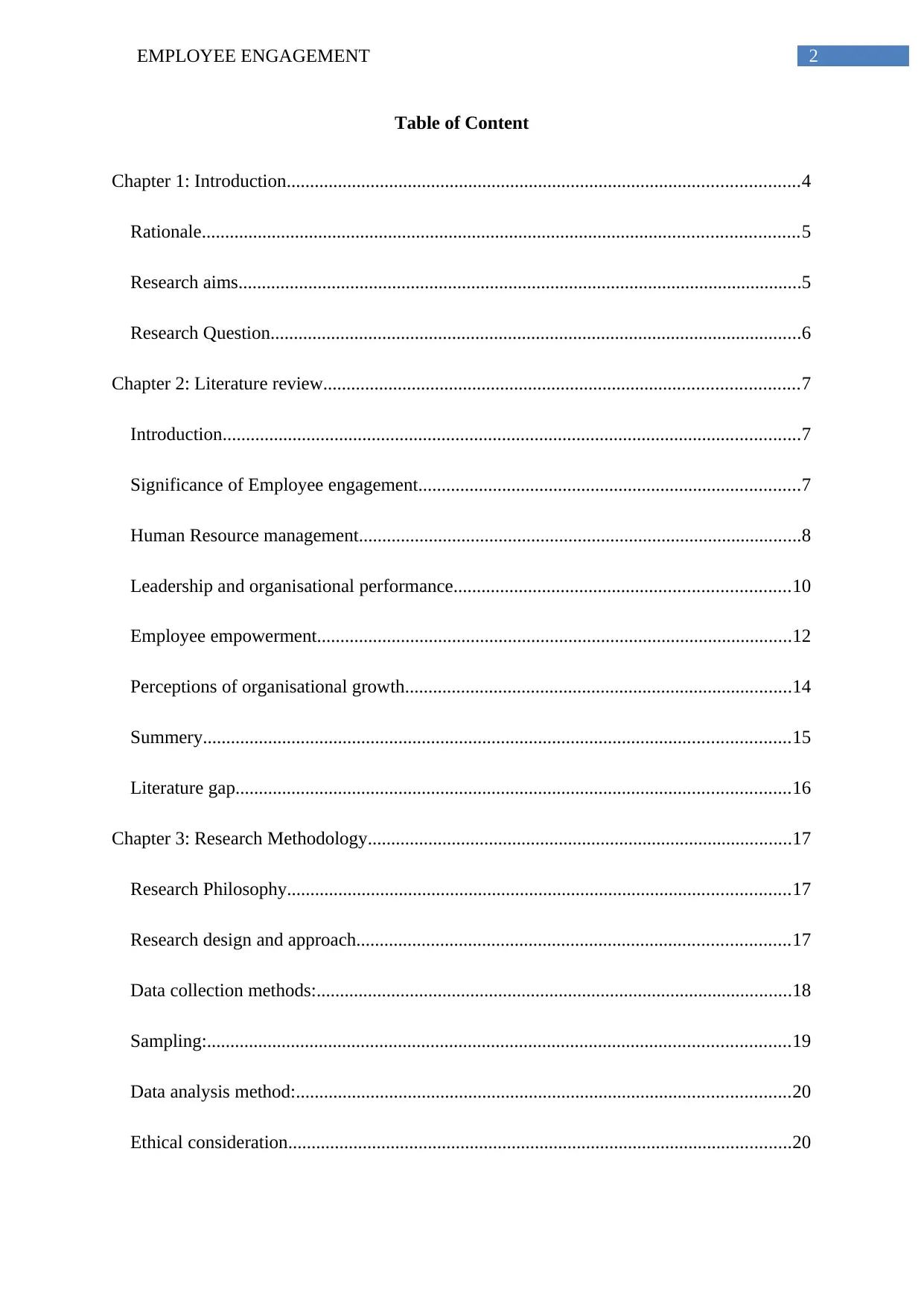
2EMPLOYEE ENGAGEMENT
Table of Content
Chapter 1: Introduction..............................................................................................................4
Rationale................................................................................................................................5
Research aims.........................................................................................................................5
Research Question..................................................................................................................6
Chapter 2: Literature review......................................................................................................7
Introduction............................................................................................................................7
Significance of Employee engagement..................................................................................7
Human Resource management...............................................................................................8
Leadership and organisational performance........................................................................10
Employee empowerment......................................................................................................12
Perceptions of organisational growth...................................................................................14
Summery..............................................................................................................................15
Literature gap.......................................................................................................................16
Chapter 3: Research Methodology...........................................................................................17
Research Philosophy............................................................................................................17
Research design and approach.............................................................................................17
Data collection methods:......................................................................................................18
Sampling:.............................................................................................................................19
Data analysis method:..........................................................................................................20
Ethical consideration............................................................................................................20
Table of Content
Chapter 1: Introduction..............................................................................................................4
Rationale................................................................................................................................5
Research aims.........................................................................................................................5
Research Question..................................................................................................................6
Chapter 2: Literature review......................................................................................................7
Introduction............................................................................................................................7
Significance of Employee engagement..................................................................................7
Human Resource management...............................................................................................8
Leadership and organisational performance........................................................................10
Employee empowerment......................................................................................................12
Perceptions of organisational growth...................................................................................14
Summery..............................................................................................................................15
Literature gap.......................................................................................................................16
Chapter 3: Research Methodology...........................................................................................17
Research Philosophy............................................................................................................17
Research design and approach.............................................................................................17
Data collection methods:......................................................................................................18
Sampling:.............................................................................................................................19
Data analysis method:..........................................................................................................20
Ethical consideration............................................................................................................20
⊘ This is a preview!⊘
Do you want full access?
Subscribe today to unlock all pages.

Trusted by 1+ million students worldwide
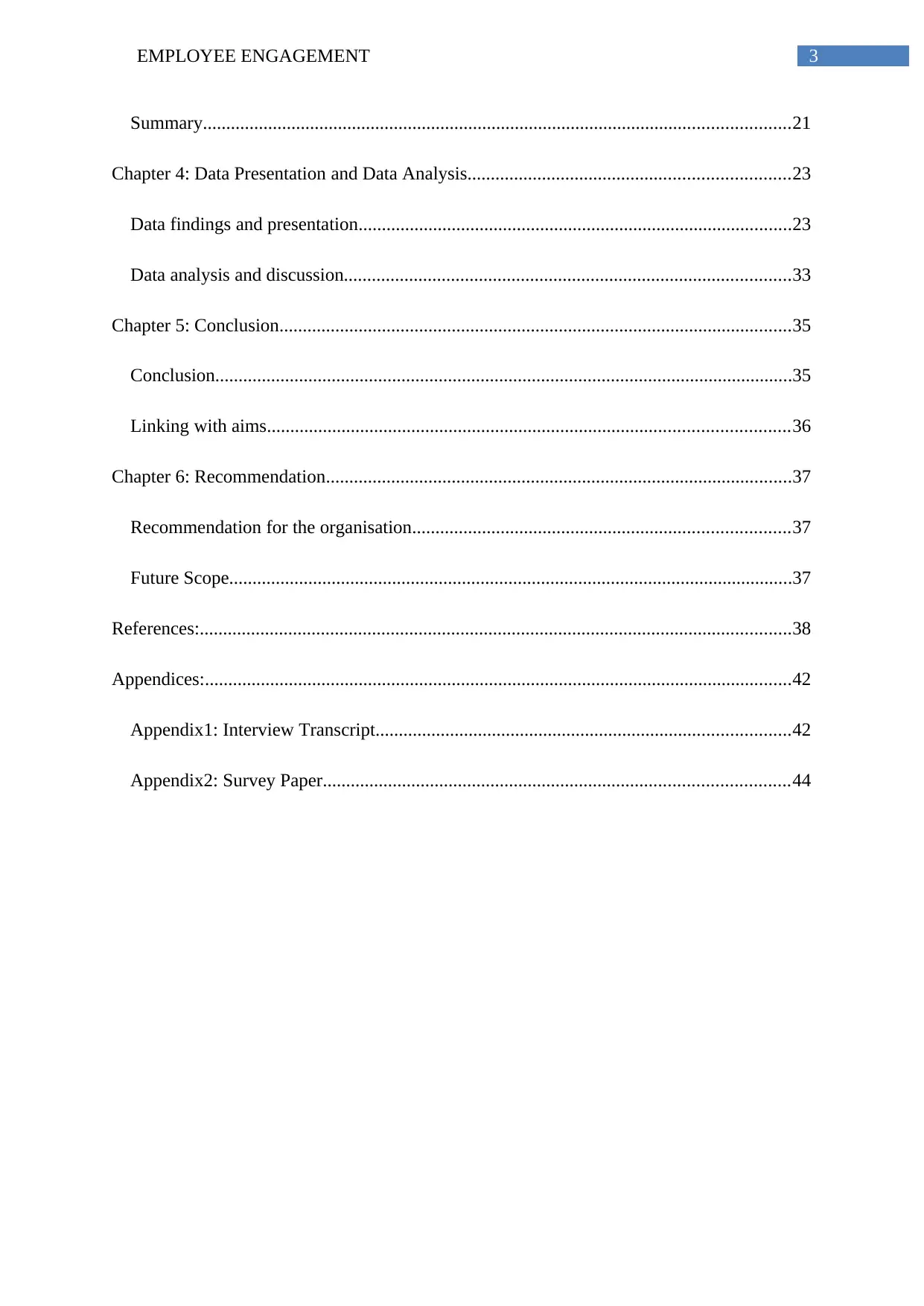
3EMPLOYEE ENGAGEMENT
Summary..............................................................................................................................21
Chapter 4: Data Presentation and Data Analysis.....................................................................23
Data findings and presentation.............................................................................................23
Data analysis and discussion................................................................................................33
Chapter 5: Conclusion..............................................................................................................35
Conclusion............................................................................................................................35
Linking with aims................................................................................................................36
Chapter 6: Recommendation....................................................................................................37
Recommendation for the organisation.................................................................................37
Future Scope.........................................................................................................................37
References:...............................................................................................................................38
Appendices:..............................................................................................................................42
Appendix1: Interview Transcript.........................................................................................42
Appendix2: Survey Paper....................................................................................................44
Summary..............................................................................................................................21
Chapter 4: Data Presentation and Data Analysis.....................................................................23
Data findings and presentation.............................................................................................23
Data analysis and discussion................................................................................................33
Chapter 5: Conclusion..............................................................................................................35
Conclusion............................................................................................................................35
Linking with aims................................................................................................................36
Chapter 6: Recommendation....................................................................................................37
Recommendation for the organisation.................................................................................37
Future Scope.........................................................................................................................37
References:...............................................................................................................................38
Appendices:..............................................................................................................................42
Appendix1: Interview Transcript.........................................................................................42
Appendix2: Survey Paper....................................................................................................44
Paraphrase This Document
Need a fresh take? Get an instant paraphrase of this document with our AI Paraphraser
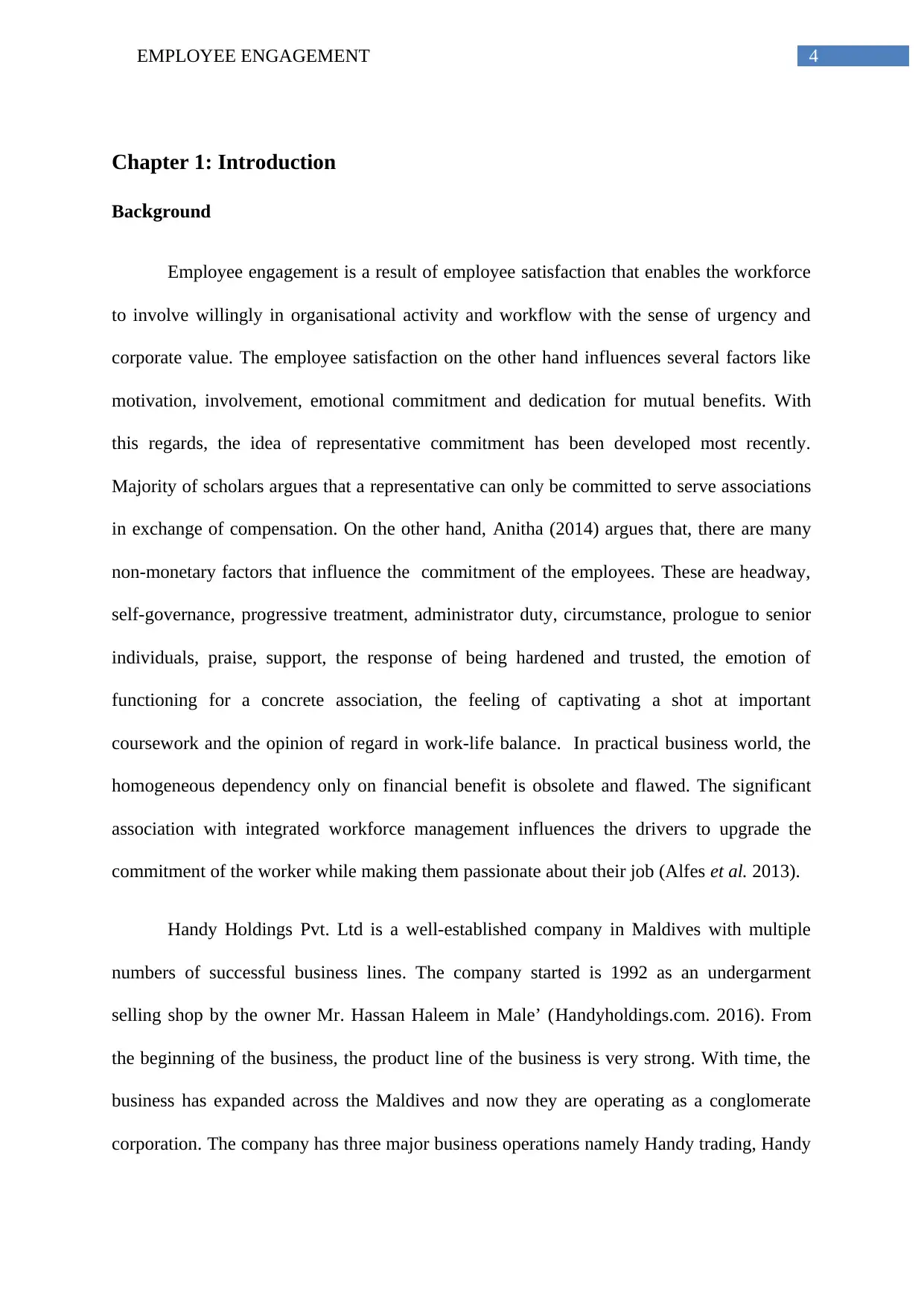
4EMPLOYEE ENGAGEMENT
Chapter 1: Introduction
Background
Employee engagement is a result of employee satisfaction that enables the workforce
to involve willingly in organisational activity and workflow with the sense of urgency and
corporate value. The employee satisfaction on the other hand influences several factors like
motivation, involvement, emotional commitment and dedication for mutual benefits. With
this regards, the idea of representative commitment has been developed most recently.
Majority of scholars argues that a representative can only be committed to serve associations
in exchange of compensation. On the other hand, Anitha (2014) argues that, there are many
non-monetary factors that influence the commitment of the employees. These are headway,
self-governance, progressive treatment, administrator duty, circumstance, prologue to senior
individuals, praise, support, the response of being hardened and trusted, the emotion of
functioning for a concrete association, the feeling of captivating a shot at important
coursework and the opinion of regard in work-life balance. In practical business world, the
homogeneous dependency only on financial benefit is obsolete and flawed. The significant
association with integrated workforce management influences the drivers to upgrade the
commitment of the worker while making them passionate about their job (Alfes et al. 2013).
Handy Holdings Pvt. Ltd is a well-established company in Maldives with multiple
numbers of successful business lines. The company started is 1992 as an undergarment
selling shop by the owner Mr. Hassan Haleem in Male’ (Handyholdings.com. 2016). From
the beginning of the business, the product line of the business is very strong. With time, the
business has expanded across the Maldives and now they are operating as a conglomerate
corporation. The company has three major business operations namely Handy trading, Handy
Chapter 1: Introduction
Background
Employee engagement is a result of employee satisfaction that enables the workforce
to involve willingly in organisational activity and workflow with the sense of urgency and
corporate value. The employee satisfaction on the other hand influences several factors like
motivation, involvement, emotional commitment and dedication for mutual benefits. With
this regards, the idea of representative commitment has been developed most recently.
Majority of scholars argues that a representative can only be committed to serve associations
in exchange of compensation. On the other hand, Anitha (2014) argues that, there are many
non-monetary factors that influence the commitment of the employees. These are headway,
self-governance, progressive treatment, administrator duty, circumstance, prologue to senior
individuals, praise, support, the response of being hardened and trusted, the emotion of
functioning for a concrete association, the feeling of captivating a shot at important
coursework and the opinion of regard in work-life balance. In practical business world, the
homogeneous dependency only on financial benefit is obsolete and flawed. The significant
association with integrated workforce management influences the drivers to upgrade the
commitment of the worker while making them passionate about their job (Alfes et al. 2013).
Handy Holdings Pvt. Ltd is a well-established company in Maldives with multiple
numbers of successful business lines. The company started is 1992 as an undergarment
selling shop by the owner Mr. Hassan Haleem in Male’ (Handyholdings.com. 2016). From
the beginning of the business, the product line of the business is very strong. With time, the
business has expanded across the Maldives and now they are operating as a conglomerate
corporation. The company has three major business operations namely Handy trading, Handy
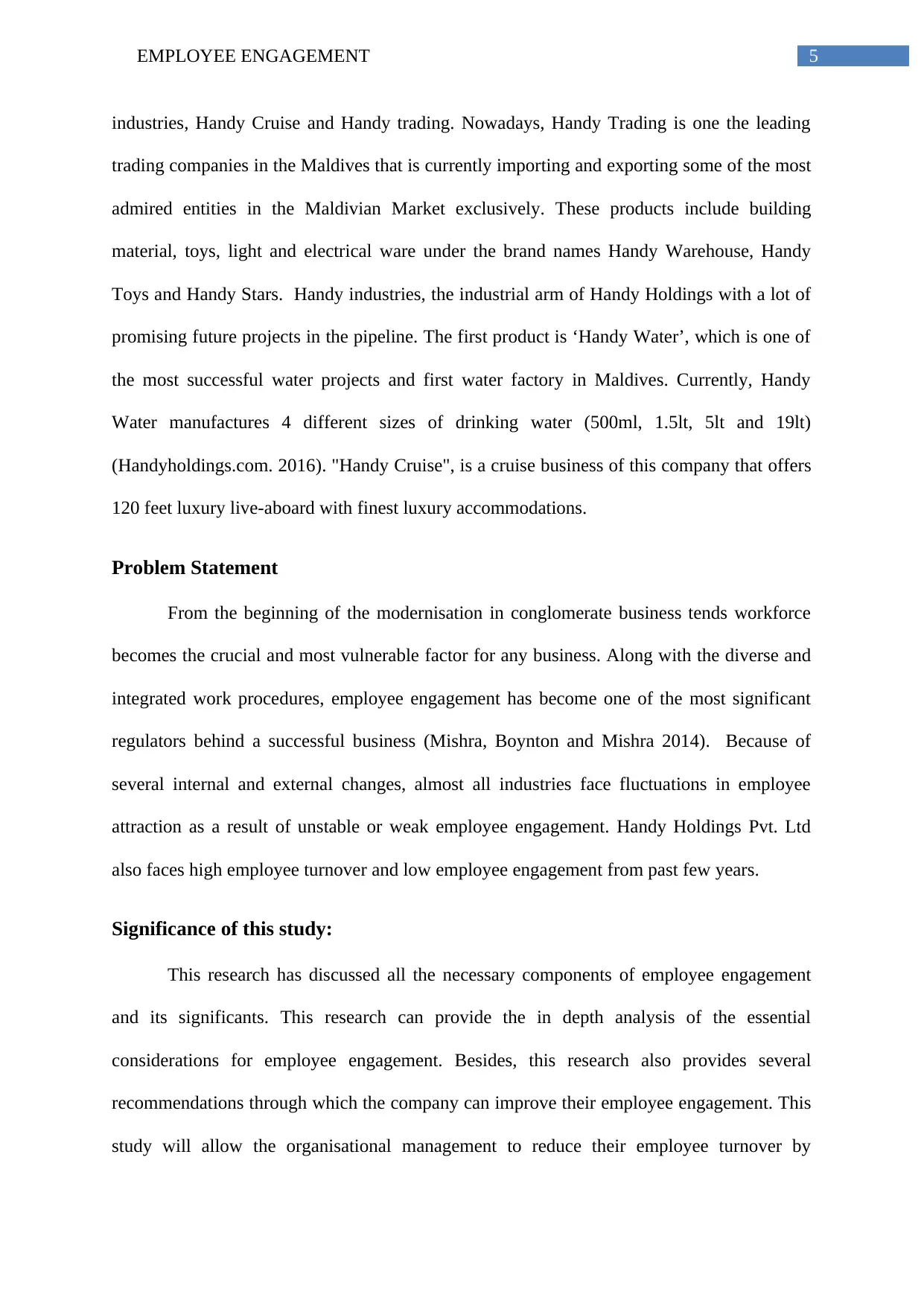
5EMPLOYEE ENGAGEMENT
industries, Handy Cruise and Handy trading. Nowadays, Handy Trading is one the leading
trading companies in the Maldives that is currently importing and exporting some of the most
admired entities in the Maldivian Market exclusively. These products include building
material, toys, light and electrical ware under the brand names Handy Warehouse, Handy
Toys and Handy Stars. Handy industries, the industrial arm of Handy Holdings with a lot of
promising future projects in the pipeline. The first product is ‘Handy Water’, which is one of
the most successful water projects and first water factory in Maldives. Currently, Handy
Water manufactures 4 different sizes of drinking water (500ml, 1.5lt, 5lt and 19lt)
(Handyholdings.com. 2016). "Handy Cruise", is a cruise business of this company that offers
120 feet luxury live-aboard with finest luxury accommodations.
Problem Statement
From the beginning of the modernisation in conglomerate business tends workforce
becomes the crucial and most vulnerable factor for any business. Along with the diverse and
integrated work procedures, employee engagement has become one of the most significant
regulators behind a successful business (Mishra, Boynton and Mishra 2014). Because of
several internal and external changes, almost all industries face fluctuations in employee
attraction as a result of unstable or weak employee engagement. Handy Holdings Pvt. Ltd
also faces high employee turnover and low employee engagement from past few years.
Significance of this study:
This research has discussed all the necessary components of employee engagement
and its significants. This research can provide the in depth analysis of the essential
considerations for employee engagement. Besides, this research also provides several
recommendations through which the company can improve their employee engagement. This
study will allow the organisational management to reduce their employee turnover by
industries, Handy Cruise and Handy trading. Nowadays, Handy Trading is one the leading
trading companies in the Maldives that is currently importing and exporting some of the most
admired entities in the Maldivian Market exclusively. These products include building
material, toys, light and electrical ware under the brand names Handy Warehouse, Handy
Toys and Handy Stars. Handy industries, the industrial arm of Handy Holdings with a lot of
promising future projects in the pipeline. The first product is ‘Handy Water’, which is one of
the most successful water projects and first water factory in Maldives. Currently, Handy
Water manufactures 4 different sizes of drinking water (500ml, 1.5lt, 5lt and 19lt)
(Handyholdings.com. 2016). "Handy Cruise", is a cruise business of this company that offers
120 feet luxury live-aboard with finest luxury accommodations.
Problem Statement
From the beginning of the modernisation in conglomerate business tends workforce
becomes the crucial and most vulnerable factor for any business. Along with the diverse and
integrated work procedures, employee engagement has become one of the most significant
regulators behind a successful business (Mishra, Boynton and Mishra 2014). Because of
several internal and external changes, almost all industries face fluctuations in employee
attraction as a result of unstable or weak employee engagement. Handy Holdings Pvt. Ltd
also faces high employee turnover and low employee engagement from past few years.
Significance of this study:
This research has discussed all the necessary components of employee engagement
and its significants. This research can provide the in depth analysis of the essential
considerations for employee engagement. Besides, this research also provides several
recommendations through which the company can improve their employee engagement. This
study will allow the organisational management to reduce their employee turnover by
⊘ This is a preview!⊘
Do you want full access?
Subscribe today to unlock all pages.

Trusted by 1+ million students worldwide
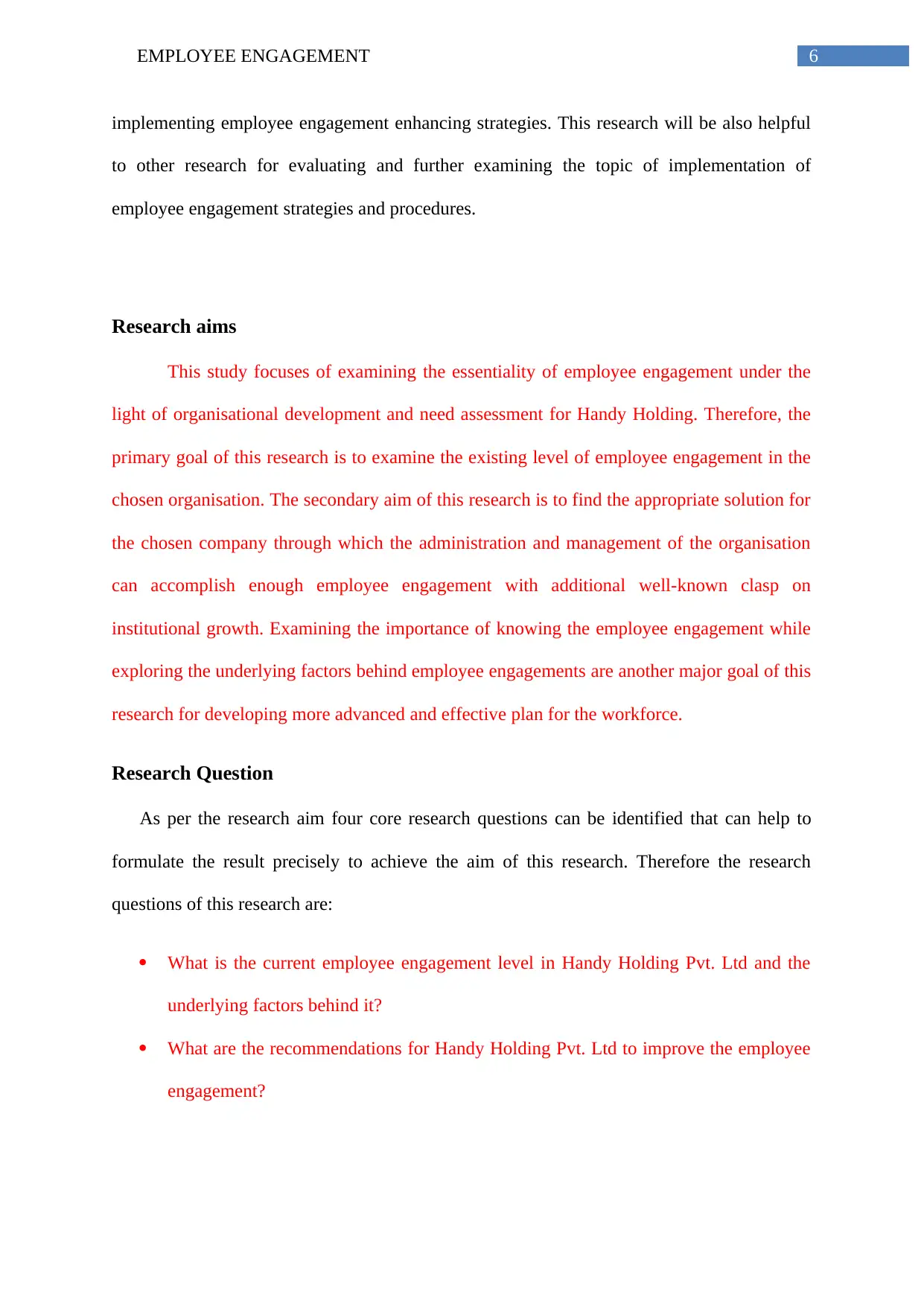
6EMPLOYEE ENGAGEMENT
implementing employee engagement enhancing strategies. This research will be also helpful
to other research for evaluating and further examining the topic of implementation of
employee engagement strategies and procedures.
Research aims
This study focuses of examining the essentiality of employee engagement under the
light of organisational development and need assessment for Handy Holding. Therefore, the
primary goal of this research is to examine the existing level of employee engagement in the
chosen organisation. The secondary aim of this research is to find the appropriate solution for
the chosen company through which the administration and management of the organisation
can accomplish enough employee engagement with additional well-known clasp on
institutional growth. Examining the importance of knowing the employee engagement while
exploring the underlying factors behind employee engagements are another major goal of this
research for developing more advanced and effective plan for the workforce.
Research Question
As per the research aim four core research questions can be identified that can help to
formulate the result precisely to achieve the aim of this research. Therefore the research
questions of this research are:
What is the current employee engagement level in Handy Holding Pvt. Ltd and the
underlying factors behind it?
What are the recommendations for Handy Holding Pvt. Ltd to improve the employee
engagement?
implementing employee engagement enhancing strategies. This research will be also helpful
to other research for evaluating and further examining the topic of implementation of
employee engagement strategies and procedures.
Research aims
This study focuses of examining the essentiality of employee engagement under the
light of organisational development and need assessment for Handy Holding. Therefore, the
primary goal of this research is to examine the existing level of employee engagement in the
chosen organisation. The secondary aim of this research is to find the appropriate solution for
the chosen company through which the administration and management of the organisation
can accomplish enough employee engagement with additional well-known clasp on
institutional growth. Examining the importance of knowing the employee engagement while
exploring the underlying factors behind employee engagements are another major goal of this
research for developing more advanced and effective plan for the workforce.
Research Question
As per the research aim four core research questions can be identified that can help to
formulate the result precisely to achieve the aim of this research. Therefore the research
questions of this research are:
What is the current employee engagement level in Handy Holding Pvt. Ltd and the
underlying factors behind it?
What are the recommendations for Handy Holding Pvt. Ltd to improve the employee
engagement?
Paraphrase This Document
Need a fresh take? Get an instant paraphrase of this document with our AI Paraphraser

7EMPLOYEE ENGAGEMENT
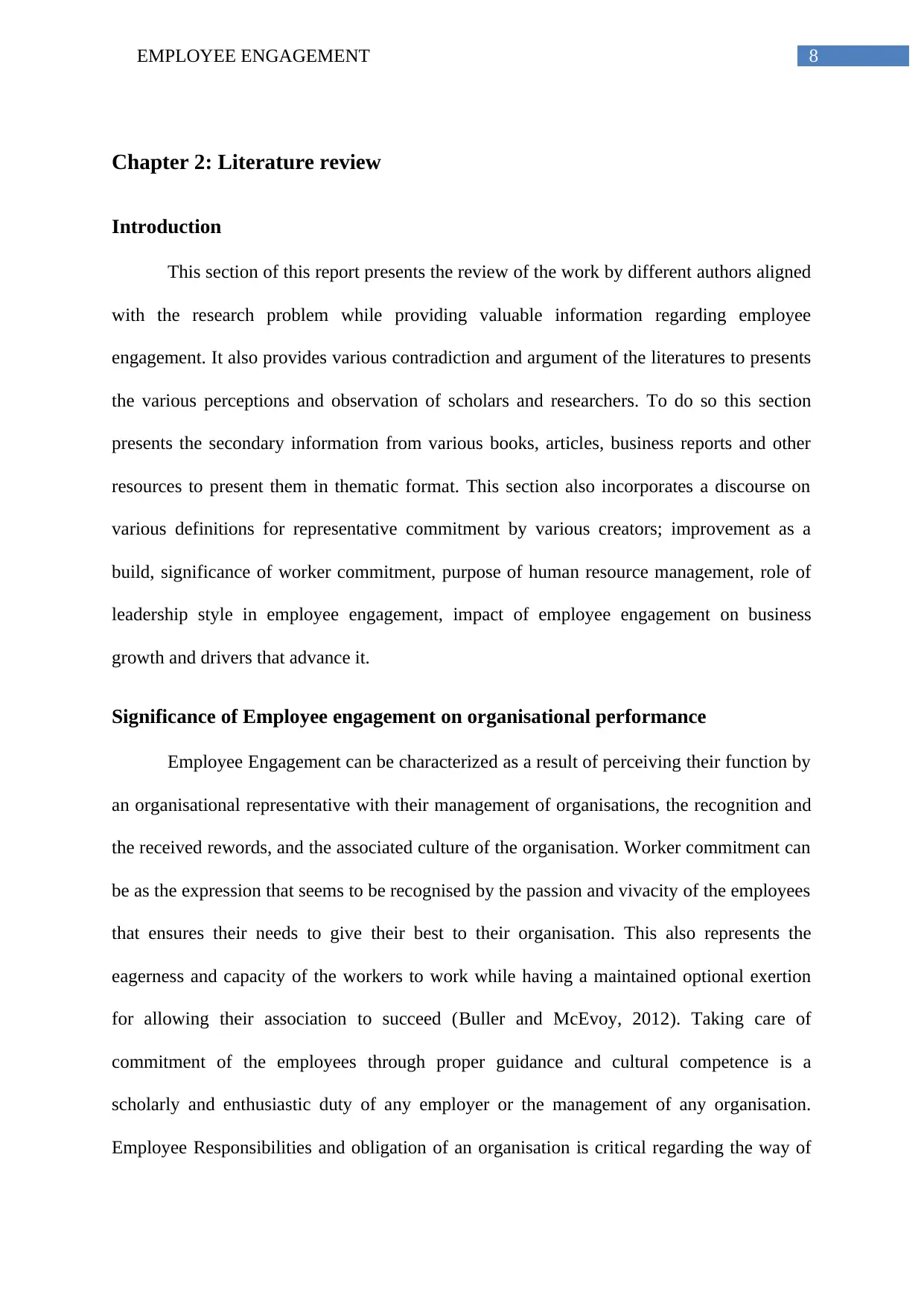
8EMPLOYEE ENGAGEMENT
Chapter 2: Literature review
Introduction
This section of this report presents the review of the work by different authors aligned
with the research problem while providing valuable information regarding employee
engagement. It also provides various contradiction and argument of the literatures to presents
the various perceptions and observation of scholars and researchers. To do so this section
presents the secondary information from various books, articles, business reports and other
resources to present them in thematic format. This section also incorporates a discourse on
various definitions for representative commitment by various creators; improvement as a
build, significance of worker commitment, purpose of human resource management, role of
leadership style in employee engagement, impact of employee engagement on business
growth and drivers that advance it.
Significance of Employee engagement on organisational performance
Employee Engagement can be characterized as a result of perceiving their function by
an organisational representative with their management of organisations, the recognition and
the received rewords, and the associated culture of the organisation. Worker commitment can
be as the expression that seems to be recognised by the passion and vivacity of the employees
that ensures their needs to give their best to their organisation. This also represents the
eagerness and capacity of the workers to work while having a maintained optional exertion
for allowing their association to succeed (Buller and McEvoy, 2012). Taking care of
commitment of the employees through proper guidance and cultural competence is a
scholarly and enthusiastic duty of any employer or the management of any organisation.
Employee Responsibilities and obligation of an organisation is critical regarding the way of
Chapter 2: Literature review
Introduction
This section of this report presents the review of the work by different authors aligned
with the research problem while providing valuable information regarding employee
engagement. It also provides various contradiction and argument of the literatures to presents
the various perceptions and observation of scholars and researchers. To do so this section
presents the secondary information from various books, articles, business reports and other
resources to present them in thematic format. This section also incorporates a discourse on
various definitions for representative commitment by various creators; improvement as a
build, significance of worker commitment, purpose of human resource management, role of
leadership style in employee engagement, impact of employee engagement on business
growth and drivers that advance it.
Significance of Employee engagement on organisational performance
Employee Engagement can be characterized as a result of perceiving their function by
an organisational representative with their management of organisations, the recognition and
the received rewords, and the associated culture of the organisation. Worker commitment can
be as the expression that seems to be recognised by the passion and vivacity of the employees
that ensures their needs to give their best to their organisation. This also represents the
eagerness and capacity of the workers to work while having a maintained optional exertion
for allowing their association to succeed (Buller and McEvoy, 2012). Taking care of
commitment of the employees through proper guidance and cultural competence is a
scholarly and enthusiastic duty of any employer or the management of any organisation.
Employee Responsibilities and obligation of an organisation is critical regarding the way of
⊘ This is a preview!⊘
Do you want full access?
Subscribe today to unlock all pages.

Trusted by 1+ million students worldwide
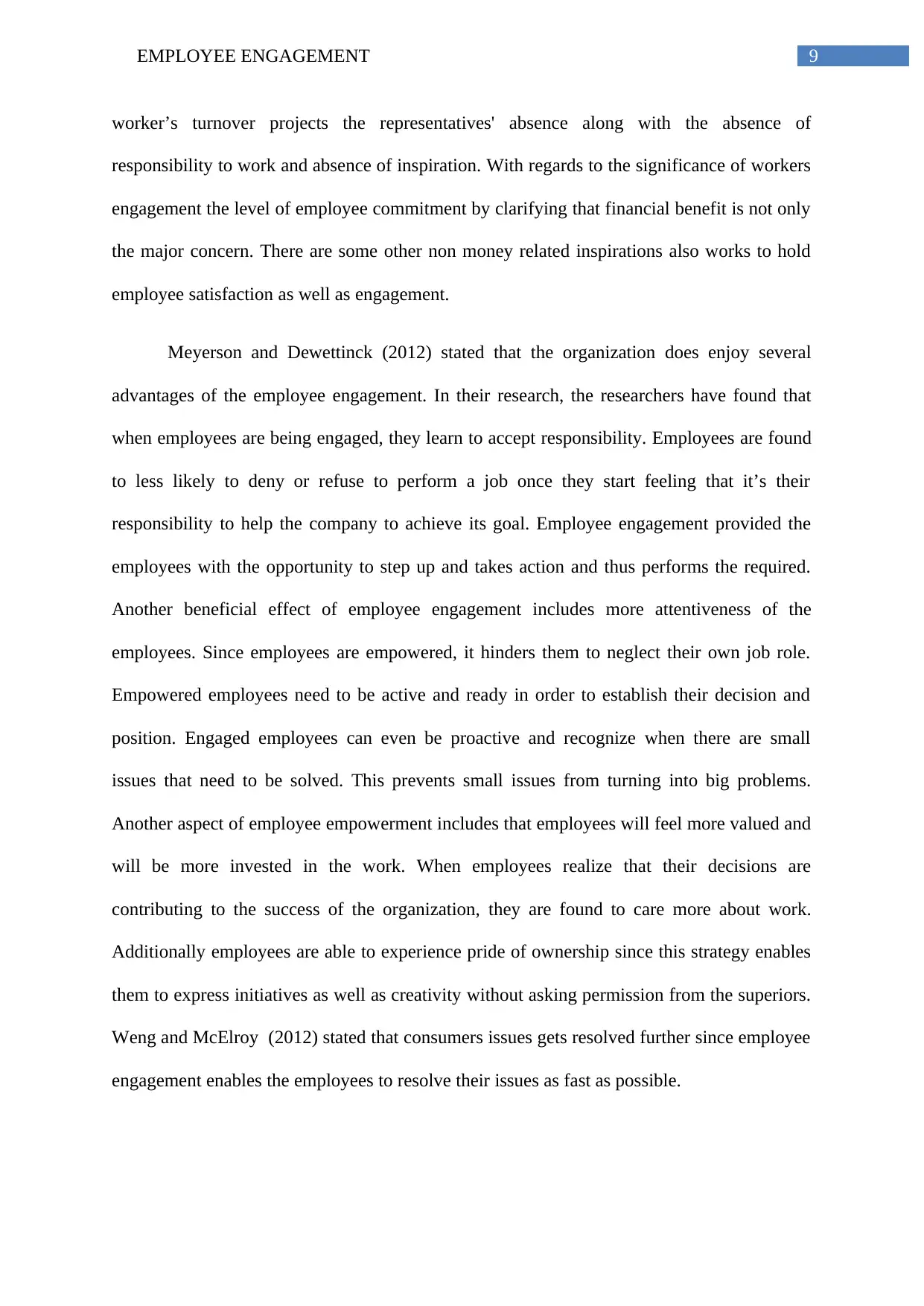
9EMPLOYEE ENGAGEMENT
worker’s turnover projects the representatives' absence along with the absence of
responsibility to work and absence of inspiration. With regards to the significance of workers
engagement the level of employee commitment by clarifying that financial benefit is not only
the major concern. There are some other non money related inspirations also works to hold
employee satisfaction as well as engagement.
Meyerson and Dewettinck (2012) stated that the organization does enjoy several
advantages of the employee engagement. In their research, the researchers have found that
when employees are being engaged, they learn to accept responsibility. Employees are found
to less likely to deny or refuse to perform a job once they start feeling that it’s their
responsibility to help the company to achieve its goal. Employee engagement provided the
employees with the opportunity to step up and takes action and thus performs the required.
Another beneficial effect of employee engagement includes more attentiveness of the
employees. Since employees are empowered, it hinders them to neglect their own job role.
Empowered employees need to be active and ready in order to establish their decision and
position. Engaged employees can even be proactive and recognize when there are small
issues that need to be solved. This prevents small issues from turning into big problems.
Another aspect of employee empowerment includes that employees will feel more valued and
will be more invested in the work. When employees realize that their decisions are
contributing to the success of the organization, they are found to care more about work.
Additionally employees are able to experience pride of ownership since this strategy enables
them to express initiatives as well as creativity without asking permission from the superiors.
Weng and McElroy (2012) stated that consumers issues gets resolved further since employee
engagement enables the employees to resolve their issues as fast as possible.
worker’s turnover projects the representatives' absence along with the absence of
responsibility to work and absence of inspiration. With regards to the significance of workers
engagement the level of employee commitment by clarifying that financial benefit is not only
the major concern. There are some other non money related inspirations also works to hold
employee satisfaction as well as engagement.
Meyerson and Dewettinck (2012) stated that the organization does enjoy several
advantages of the employee engagement. In their research, the researchers have found that
when employees are being engaged, they learn to accept responsibility. Employees are found
to less likely to deny or refuse to perform a job once they start feeling that it’s their
responsibility to help the company to achieve its goal. Employee engagement provided the
employees with the opportunity to step up and takes action and thus performs the required.
Another beneficial effect of employee engagement includes more attentiveness of the
employees. Since employees are empowered, it hinders them to neglect their own job role.
Empowered employees need to be active and ready in order to establish their decision and
position. Engaged employees can even be proactive and recognize when there are small
issues that need to be solved. This prevents small issues from turning into big problems.
Another aspect of employee empowerment includes that employees will feel more valued and
will be more invested in the work. When employees realize that their decisions are
contributing to the success of the organization, they are found to care more about work.
Additionally employees are able to experience pride of ownership since this strategy enables
them to express initiatives as well as creativity without asking permission from the superiors.
Weng and McElroy (2012) stated that consumers issues gets resolved further since employee
engagement enables the employees to resolve their issues as fast as possible.
Paraphrase This Document
Need a fresh take? Get an instant paraphrase of this document with our AI Paraphraser
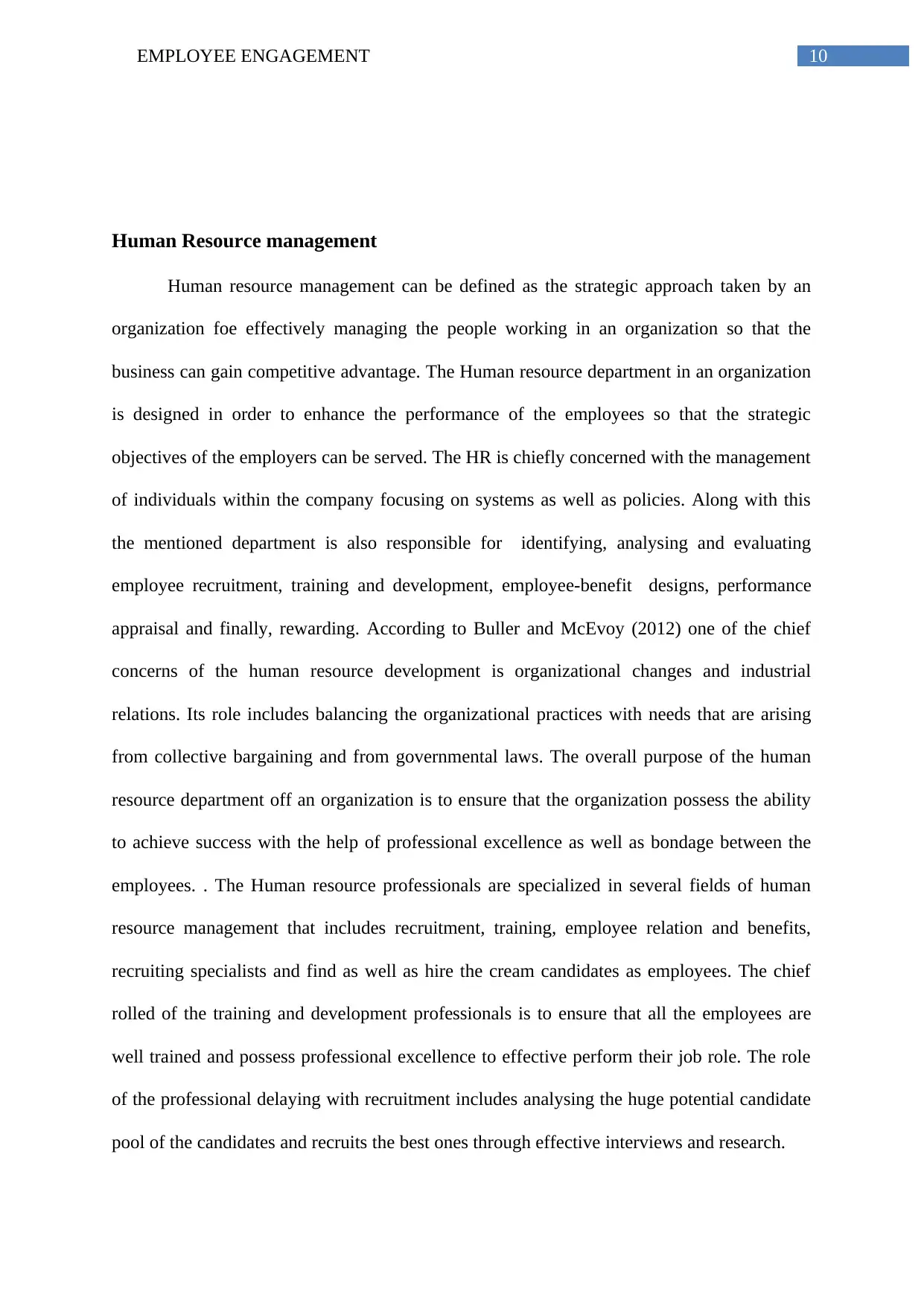
10EMPLOYEE ENGAGEMENT
Human Resource management
Human resource management can be defined as the strategic approach taken by an
organization foe effectively managing the people working in an organization so that the
business can gain competitive advantage. The Human resource department in an organization
is designed in order to enhance the performance of the employees so that the strategic
objectives of the employers can be served. The HR is chiefly concerned with the management
of individuals within the company focusing on systems as well as policies. Along with this
the mentioned department is also responsible for identifying, analysing and evaluating
employee recruitment, training and development, employee-benefit designs, performance
appraisal and finally, rewarding. According to Buller and McEvoy (2012) one of the chief
concerns of the human resource development is organizational changes and industrial
relations. Its role includes balancing the organizational practices with needs that are arising
from collective bargaining and from governmental laws. The overall purpose of the human
resource department off an organization is to ensure that the organization possess the ability
to achieve success with the help of professional excellence as well as bondage between the
employees. . The Human resource professionals are specialized in several fields of human
resource management that includes recruitment, training, employee relation and benefits,
recruiting specialists and find as well as hire the cream candidates as employees. The chief
rolled of the training and development professionals is to ensure that all the employees are
well trained and possess professional excellence to effective perform their job role. The role
of the professional delaying with recruitment includes analysing the huge potential candidate
pool of the candidates and recruits the best ones through effective interviews and research.
Human Resource management
Human resource management can be defined as the strategic approach taken by an
organization foe effectively managing the people working in an organization so that the
business can gain competitive advantage. The Human resource department in an organization
is designed in order to enhance the performance of the employees so that the strategic
objectives of the employers can be served. The HR is chiefly concerned with the management
of individuals within the company focusing on systems as well as policies. Along with this
the mentioned department is also responsible for identifying, analysing and evaluating
employee recruitment, training and development, employee-benefit designs, performance
appraisal and finally, rewarding. According to Buller and McEvoy (2012) one of the chief
concerns of the human resource development is organizational changes and industrial
relations. Its role includes balancing the organizational practices with needs that are arising
from collective bargaining and from governmental laws. The overall purpose of the human
resource department off an organization is to ensure that the organization possess the ability
to achieve success with the help of professional excellence as well as bondage between the
employees. . The Human resource professionals are specialized in several fields of human
resource management that includes recruitment, training, employee relation and benefits,
recruiting specialists and find as well as hire the cream candidates as employees. The chief
rolled of the training and development professionals is to ensure that all the employees are
well trained and possess professional excellence to effective perform their job role. The role
of the professional delaying with recruitment includes analysing the huge potential candidate
pool of the candidates and recruits the best ones through effective interviews and research.
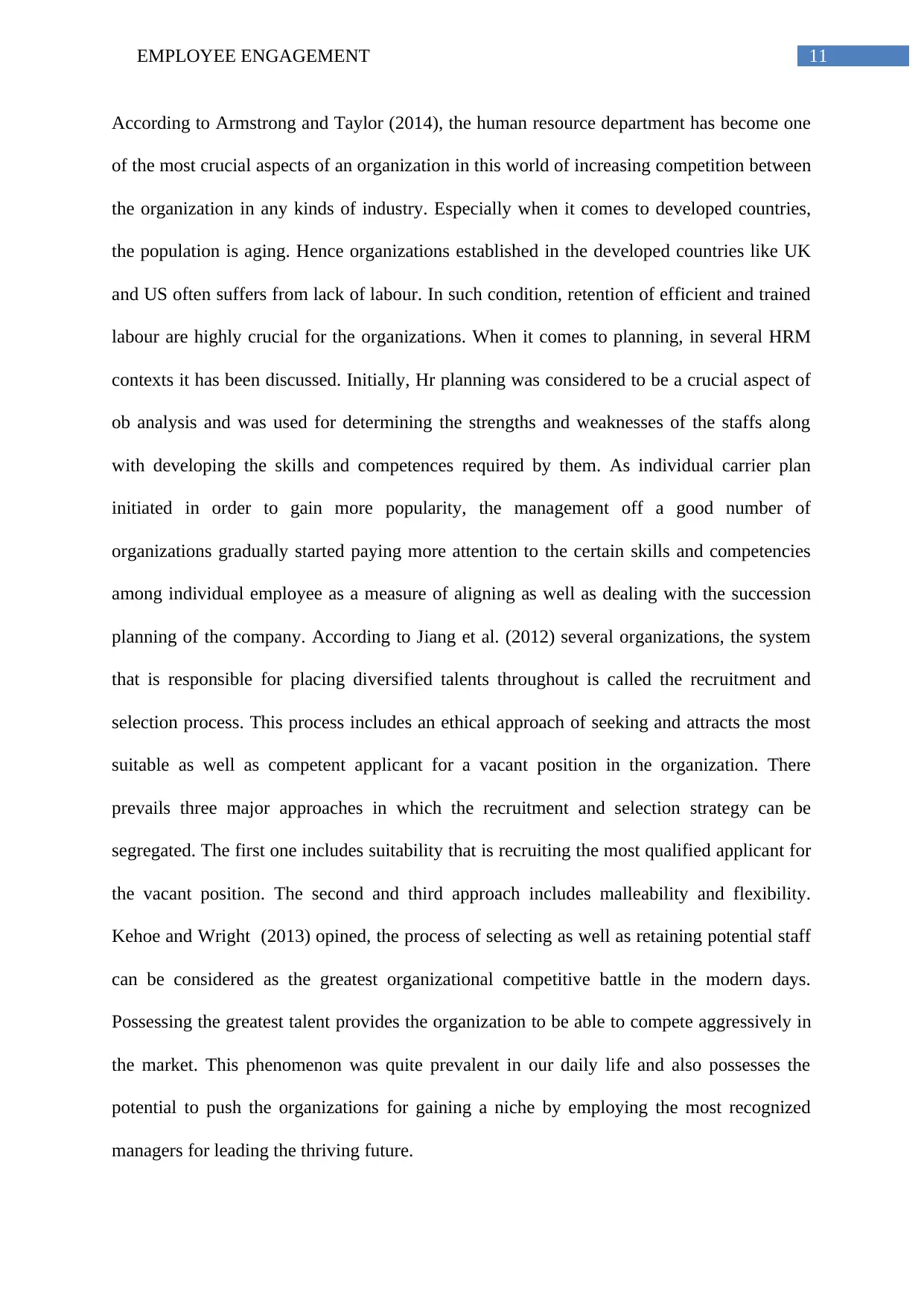
11EMPLOYEE ENGAGEMENT
According to Armstrong and Taylor (2014), the human resource department has become one
of the most crucial aspects of an organization in this world of increasing competition between
the organization in any kinds of industry. Especially when it comes to developed countries,
the population is aging. Hence organizations established in the developed countries like UK
and US often suffers from lack of labour. In such condition, retention of efficient and trained
labour are highly crucial for the organizations. When it comes to planning, in several HRM
contexts it has been discussed. Initially, Hr planning was considered to be a crucial aspect of
ob analysis and was used for determining the strengths and weaknesses of the staffs along
with developing the skills and competences required by them. As individual carrier plan
initiated in order to gain more popularity, the management off a good number of
organizations gradually started paying more attention to the certain skills and competencies
among individual employee as a measure of aligning as well as dealing with the succession
planning of the company. According to Jiang et al. (2012) several organizations, the system
that is responsible for placing diversified talents throughout is called the recruitment and
selection process. This process includes an ethical approach of seeking and attracts the most
suitable as well as competent applicant for a vacant position in the organization. There
prevails three major approaches in which the recruitment and selection strategy can be
segregated. The first one includes suitability that is recruiting the most qualified applicant for
the vacant position. The second and third approach includes malleability and flexibility.
Kehoe and Wright (2013) opined, the process of selecting as well as retaining potential staff
can be considered as the greatest organizational competitive battle in the modern days.
Possessing the greatest talent provides the organization to be able to compete aggressively in
the market. This phenomenon was quite prevalent in our daily life and also possesses the
potential to push the organizations for gaining a niche by employing the most recognized
managers for leading the thriving future.
According to Armstrong and Taylor (2014), the human resource department has become one
of the most crucial aspects of an organization in this world of increasing competition between
the organization in any kinds of industry. Especially when it comes to developed countries,
the population is aging. Hence organizations established in the developed countries like UK
and US often suffers from lack of labour. In such condition, retention of efficient and trained
labour are highly crucial for the organizations. When it comes to planning, in several HRM
contexts it has been discussed. Initially, Hr planning was considered to be a crucial aspect of
ob analysis and was used for determining the strengths and weaknesses of the staffs along
with developing the skills and competences required by them. As individual carrier plan
initiated in order to gain more popularity, the management off a good number of
organizations gradually started paying more attention to the certain skills and competencies
among individual employee as a measure of aligning as well as dealing with the succession
planning of the company. According to Jiang et al. (2012) several organizations, the system
that is responsible for placing diversified talents throughout is called the recruitment and
selection process. This process includes an ethical approach of seeking and attracts the most
suitable as well as competent applicant for a vacant position in the organization. There
prevails three major approaches in which the recruitment and selection strategy can be
segregated. The first one includes suitability that is recruiting the most qualified applicant for
the vacant position. The second and third approach includes malleability and flexibility.
Kehoe and Wright (2013) opined, the process of selecting as well as retaining potential staff
can be considered as the greatest organizational competitive battle in the modern days.
Possessing the greatest talent provides the organization to be able to compete aggressively in
the market. This phenomenon was quite prevalent in our daily life and also possesses the
potential to push the organizations for gaining a niche by employing the most recognized
managers for leading the thriving future.
⊘ This is a preview!⊘
Do you want full access?
Subscribe today to unlock all pages.

Trusted by 1+ million students worldwide
1 out of 49
Related Documents
Your All-in-One AI-Powered Toolkit for Academic Success.
+13062052269
info@desklib.com
Available 24*7 on WhatsApp / Email
![[object Object]](/_next/static/media/star-bottom.7253800d.svg)
Unlock your academic potential
Copyright © 2020–2025 A2Z Services. All Rights Reserved. Developed and managed by ZUCOL.





